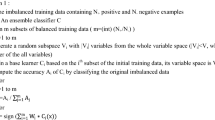Abstract
In previous work, we showed that the use of Multiple Input Representation(MIR) for the classification of time series data provides complementary information that leads to better accuracy. [4]. In this paper, we introduce the Static Minimization-Maximization approach to build Multiple Classifier Systems(MCSs) using MIR. SMM consists of two steps. In the minimization step, a greedy algorithm is employed to iteratively select the classifiers from the knowledge space to minimize the training error of MCSs. In the maximization step, a modified version of Behavior Knowledge Space(BKS), Balanced Behavior Knowledge Space(BBKS), is used to maximize the expected accuracy of the whole system given that the training error is minimized. Several popular techniques including AdaBoost, Bagging and Random Subspace are used as the benchmark to evaluate the proposed approach on four time series data sets. The results obtained from our experiments show that the performance of the proposed approach is effective as well as robust for the classification of time series data. In addition, this approach could be further extended to other applications in our future research.
Preview
Unable to display preview. Download preview PDF.
Similar content being viewed by others
References
Breiman, L., Friedman, J.H., Olshen, A., Stone, C.J.: Classification and regression trees. Chapman and Hall, New York (1993); Previously published by Wadsworth and Books/Cole (1984)
Breiman, L.: Bagging predictors. Machie Learning 26, 123–140 (1996)
Breiman, L.: Random forests. Machie Learning 45(1), 5–32 (2001)
Chen, L., Kamel, M., Jiang, J.: A modular system for classification of time series data. In: Roli, F., Kittler, J., Windeatt, T. (eds.) MCS 2004. LNCS, vol. 3077, pp. 134–143. Springer, Heidelberg (2004)
Duda, R.O., Hart, P.E., Stork, D.G.: Pattern classification, 2nd edn. Wiely-Interscience, Hoboken (2000)
Diez, J.J.R., González, C.J.A.: Applying boosting to similarity literals for time series classification. In: Kittler, J., Roli, F. (eds.) MCS 2000. LNCS, vol. 1857, pp. 210–219. Springer, Heidelberg (2000)
Dietterich, T.G.: An experimental comparison of three methods of constructing ensembles of decision trees: bagging,boositing and randomization. Machine Learning 40(2), 139–157 (2000)
Ghosh, J., Beck, S., Chu, C.C.: Evidence combination techniques for robust classification of short-duration oceanic signals. In: SPIE Conf. on Adaptive and Learning Systems, vol. 1706, pp. 266–276 (1999)
González, C.J.A., Diez, J.R.: Time series classification by boosting interval based literals. Inteligencia Artificial, Revista Iberoamericana de Inteligencia Artificial 11, 2–11 (2000)
Ghosh, J., Deuser, L., Beck, S.: A neural network based hybrid system for detection,characterization and classification of short-duration oceanic signals. IEEE Journal of Ocean Engineering 17(4), 351–363 (1992)
Giancinto, G., Roli, F.: Dynamic classifier selection based on multiple classifier behaviour. Pattern Recognition 34(9), 1879–1881 (2001)
Hsu, W.H., Ray, S.R.: Construction of recurrent mixture models for time series classification. In: Proceedings of the International Joint Conference on Neural Networks, vol. 3, pp. 1574–1579 (1999)
Huang, Y.S., Suen, C.Y.: A method of combining multiple experts for the recognition of unconstrained handwritten numerals. IEEE Transactions on Pattern Analysis and Machine Intelligence 17(1), 90–94 (1995)
Hastie, T., Tibshirani, R., Friedman, J.: Elements of statistical learning: data mining, inference, and prediction. Springer, Heidelberg (2001)
Ho, T.K.: The random subspace method for constructing decision forests. IEEE Transactions on pattern analysis and machine in intelligence 20(8), 832–844 (1998)
Saito, N.: Local feature extraction and its applications using a library of bases. Phd thesis, Department of Mathematics, Yale University (1994)
Sancho, Q., Moro, I., Alonso, C., Rodrguez, J.J.: Applying simple combining techniques with artificial neural networks to some standard time series classification problems. In: Corchado, J.M., Alonso, L., Fyfe, C. (eds.) Artificial Neural Networks in Pattern Recognition, pp. 43–50 (2001)
Author information
Authors and Affiliations
Editor information
Editors and Affiliations
Rights and permissions
Copyright information
© 2005 Springer-Verlag Berlin Heidelberg
About this paper
Cite this paper
Chen, L., Kamel, M.S. (2005). Design of Multiple Classifier Systems for Time Series Data. In: Oza, N.C., Polikar, R., Kittler, J., Roli, F. (eds) Multiple Classifier Systems. MCS 2005. Lecture Notes in Computer Science, vol 3541. Springer, Berlin, Heidelberg. https://doi.org/10.1007/11494683_22
Download citation
DOI: https://doi.org/10.1007/11494683_22
Publisher Name: Springer, Berlin, Heidelberg
Print ISBN: 978-3-540-26306-7
Online ISBN: 978-3-540-31578-0
eBook Packages: Computer ScienceComputer Science (R0)




